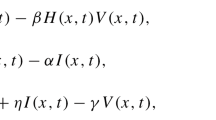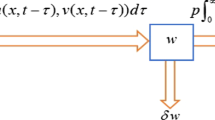Abstract
In this paper we put forward a viral propagation model with a nonlinear infection rate and free boundaries and investigate the dynamical properties. This model is composed of two ordinary differential equations and one partial differential equation, in which the spatial range of the first equation is the whole space ℝ, and the last two equations have free boundaries. As a new mathematical model, we prove the existence, uniqueness and uniform estimates of the global solution, and provide the criteria for spreading and vanishing, and the long time behavior of the solution components u, v and w. Comparing this model with the corresponding ordinary differential systems, the basic reproduction number \({{\cal R}_0}\) plays a different role. We find that when \({{\cal R}_0} \le 1\), the virus cannot spread successfully; when \({{\cal R}_0} > 1\), the successful spread of virus depends on the initial value and varying parameters.
Similar content being viewed by others
References
Ahn I, Baek S, Lin Z G. The spreading fronts of an infective environment in a man-environment-man epidemic model. Appl Math Model, 2016, 40: 7082–7101
Bunting G, Du Y H, Krakowski K. Spreading speed revisited: Analysis of a free boundary model. Netw Heterog Media, 2012, 42: 583–603
Capasso V, Maddalena L. Convergence to equilibrium states for a reaction-diffusion system modelling the spatial spread of a class of bacterial and viral diseases. J Math Biol, 1981, 13: 173–184
Du Y H, Lin Z G. Spreading-vanishing dichotomy in the diffusive logistic model with a free boundary. SIAM J Math Anal, 2010, 42: 377–405
Du Y H, Lin Z G. The diffusive competition model with a free boundary: Invasion of a superior or inferior competitor. Discrete Contin Dyn Syst Ser B, 2014, 19: 3105–3132
Du Y H, Ma L. Logistic type equations on ℝN by a squeezing method involving boundary blow-up solutions. J Lond Math Soc (2), 2001, 64: 107–124
Du Y H, Wang M X, Zhou M L. Semi-wave and spreading speed for the diffusive competition model with a free boundary. J Math Pures Appl (9), 2017, 107: 253–287
Guo J S, Wu C H. On a free boundary problem for a two-species weak competition system. J Dynam Differential Equations, 2012, 24: 873–895
Guo J S, Wu C H. Dynamics for a two-species competition-diffusion model with two free boundaries. Nonlinearity, 2015, 28: 1–27
Lewis M A, Schmitz G. Biological invasion of an organism with separate mobile and stationary states: Modelling and analysis. Forma, 1996, 11: 1–25
Li L, Sheng W J, Wang M X. Systems with nonlocal vs. local diffusions and free boundaries. J Math Anal Appl, 2020, 483: 123646
Liu S Y, Huang H M, Wang M X. A free boundary problem for a prey-predator model with degenerate diffusion and predator-stage structure. Discrete Contin Dyn Syst Ser B, 2020, 25: 1649–1670
Liu S Y, Wang M X. Existence and uniqueness of solution of free boundary problem with partially degenerate diffusion. Nonlinear Anal Real World Appl, 2020, 54: 103097
Nowak M A, Bangham C R M. Population dynamics of immune responses to persistent viruses. Science, 1996, 272: 74–79
Nowak M A, May R M. Virus Dynamics: Mathematical Principles of Immunology and Virology. Oxford: Oxford University Press, 2000
Perelson A S, Neumann A U, Markowitz M, et al. HIV-1 dynamics in vivo: Virion clearance rate, infected cell life-span, and viral generation time. Science, 1996, 271: 1582–1586
Stancevic O, Angstmann C N, Murray J M, et al. Turing patterns from dynamics of early HIV infection. Bull Math Biol, 2013, 75: 774–795
Wang J, Cao J F. The spreading frontiers in partially degenerate reaction-diffusion systems. Nonlinear Anal, 2015, 122: 215–238
Wang J P, Wang M X. The diffusive Beddington-DeAngelis predator-prey model with nonlinear prey-taxis and free boundary. Math Methods Appl Sci, 2018, 41: 6741–6762
Wang M X. On some free boundary problems of the prey-predator model. J Differential Equations, 2014, 256: 3365–3394
Wang M X. A diffusive logistic equation with a free boundary and sign-changing coefficent in time-periodic environment. J Funct Anal, 2016, 270: 483–508
Wang M X. Existence and uniqueness of solutions of free boundary problems in heterogeneous environments. Discrete Contin Dyn Syst Ser B, 2019, 24: 415–421
Wang M X, Zhang Q Y. Dynamics for the diffusive Leslie-Gower model with double free boundaries. Discrete Contin Dyn Syst, 2018, 38: 2591–2607
Wang M X, Zhang Y. Two kinds of free boundary problems for the diffusive prey-predator model. Nonlinear Anal Real World Appl, 2015, 24: 73–82
Wang M X, Zhang Y. The time-periodic diffusive competition models with a free boundary and sign-changing growth rates. Z Angew Math Phys, 2016, 67: 132
Wang M X, Zhang Y. Note on a two-species competition-diffusion model with two free boundaries. Nonlinear Anal, 2017, 159: 458–467
Wang M X, Zhang Y. Dynamics for a diffusive prey-predator model with different free boundaries. J Differential Equations, 2018, 264: 3527–3558
Wang M X, Zhao J F. Free boundary problems for a Lotka-Volterra competition system. J Dynam Differential Equations, 2014, 26: 655–672
Wang M X, Zhao J F. A free boundary problem for the predator-prey model with double free boundaries. J Dynam Differential Equations, 2017, 29: 957–979
Wang M X, Zhao Y G. Free boundary problems for the diffusive competition system in higher dimension with sign-changing coefficients. IMA J Appl Math, 2016, 81: 255–280
Wang W D, Zhao X Q. Basic reproduction numbers for reaction-diffusion epidemic models. SIAM J Appl Dyn Syst, 2012, 11: 1652–1673
Wei X P, Ghosh S K, Taylor M E, et al. Viral dynamics in human immunodeficiency virus type 1 infection. Nature, 1995, 373: 117–122
Zhang Q Y, Wang M X. Dynamics for the diffusive mutualist model with advection and different free boundaries. J Math Anal Appl, 2019, 474: 1512–1535
Zhao J F, Wang M X. A free boundary problem of a predator-prey model with higher dimension and heterogeneous environment. Nonlinear Anal Real World Appl, 2014, 16: 250–263
Acknowledgements
This work was supported by National Natural Science Foundation of China (Grant Nos. 11771110 and 11971128). The authors thank the reviewers for their helpful comments and suggestions that significantly improve the initial version of this paper.
Author information
Authors and Affiliations
Corresponding author
Rights and permissions
About this article
Cite this article
Li, L., Liu, S. & Wang, M. A viral propagation model with a nonlinear infection rate and free boundaries. Sci. China Math. 64, 1971–1992 (2021). https://doi.org/10.1007/s11425-020-1680-0
Received:
Accepted:
Published:
Issue Date:
DOI: https://doi.org/10.1007/s11425-020-1680-0
Keywords
- viral propagation model
- free boundaries
- basic reproduction number
- spreading-vanishing
- long time behavior




